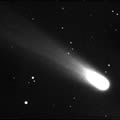|
Summary: In Early
March 2002, Comet Ikeya-Zhang became a naked-eye fuzzball in the evening
sky. It soon brightened to 3rd magnitude and delighted sky watchers
with its remarkable photogenic tail. The comet even had a stunning close
encounter with the Andromeda Galaxy. But all good things must come to
an end. On April 30th, Ikeya-Zhang made its closest approach to Earth
(0.41 AU) and since then has been receding toward the outer solar system.
The fading fuzzball now (on May 2, 2002) glows like a 5th
magnitude star at the limit of naked-eye visibility. Soon it will
be impossible to see without a telescope. So farewell, Ikeya-Zhang!
It was a great show while it lasted.
|
Spaceweather.com
wishes to thank all those who submitted to the Comet Ikeya-Zhang
gallery! The comet is now fading, and the gallery is now closed
to submissions.
|
 |
|
|
Unless
otherwise stated, all images are copyrighted by the photographers.
| |
Photographer, Location,
Date |
Larger images |
Comments |
|
|
Marco
Cosmacini,
Monte Jonaz, Italy
March 10 |
#1 |
Taken with a Takahashi 106mm refractor
and Fuji 800 ISO film, this image of the comet by Marco Cosmacini
is a sum of three stacked exposures. |
|
|
Jeff
Ball,
Gallia County, OH
March 10 |
#1 |
This brilliant image of Ikeya-Zhang
by Jeff Ball represents a 15-minute exposure, processed in Photoshop. |
|
|
Prasad
Agrahar,
Manila, Philippines
March 10 |
#1 |
This image, captured about 40 miles
from Manila, was taken on March 10th, scanned, and enhanced in
Photoshop. |
|
|
Ulrich
Beinert, Bernd
Gährken
Kronberg
March 10 |
#1,
#2 |
Ulrich Beinert: "A friend of
mine (Bernd Gährken) took a high-resolution B&W photo at
the same time as I took my color photo. We combined the color
and B&W photos to an LRGB. The date was March 10th, the time about
19:30 UT." |
|
|
Mike
Oleary , El Cajon, California
March 10 |
#1 |
Mike Oleary: "An image of Comet
Ikeya-Zhang captured on Sunday, March 10, 2002. I used an )M-1
at the prime focus of a Televue NP-101 @ f/5.4. Film was Fuji
800. Exposure was 4 min." |
|
|
Kurt-Peter
Zirn, Wendlingen, Germany
March 10 |
#1 |
By Kurt-Peter Zirn. Taken March
10th, 21h UT with a Pentay 75mm refractor and a ST237 CCD-camera.
Exposure time: 4 minutes. |
|

|
Dr.
P. Clay Sherrod, Arkansas Sky Observatory, Arkansas, USA
March 10 |
#1,
more |
Clay Sherrod: "The comet has
brightened significantly since March 8. I was able to get a very
good photometric CCD reading against EPSILON PISCES (mag. 4.25)
to which the comet was significantly brighter at MAGNITUDE 4.13,
clearly visible to the naked eye. In 10 x 50 binoculars the tail
measured 5.7 degrees in twilight." |
|
|
Alex
Roca and Angels Escuer, Hortoneda, Lerida, Spain
March 10 |
#1 |
Alex Roca hand-guided this image,
which shows the elusive Zodiacal Light in the background. Mars
is the brightest object at the very top of the image. |
|
|
Michal
Palka & Klet Observatory, Czech Republic
March 10 |
#1,
#2, #3 |
Michal Palka: All the pictures were
made at Observatory Klet, Czech Republic by me, on Sunday 10th
March 2002 through Zeis - Sonnar 200 mm @ f/4 on Kodak Royal 400
negative material. Scanned directly from negative, no digital
processing. The tale of the comet apears to be aprox. 8 degrees
long (!). |
|
|
Bartek
Okonek, Leszno, Poland
March 10 |
#1 |
A 30 sec. exposure of Ikeya-Zhang
on Kodak Supra 800, 58mm at f2.0. |
|

|
Steve
Rismiller, Cincinnati, Ohio, USA
March 10 |
#1 |
S. Rismiller: "This image
reminds me of the view as seen through 10 x 70 binoculars from
the Cincinnati, Ohio area." Photo details: 102 mm ED Vixen
refractor, 32 mm Brandon eyepiece, Nikon 995 digital camera, and
a 1 minute exposure. |
back
to spaceweather.com |










